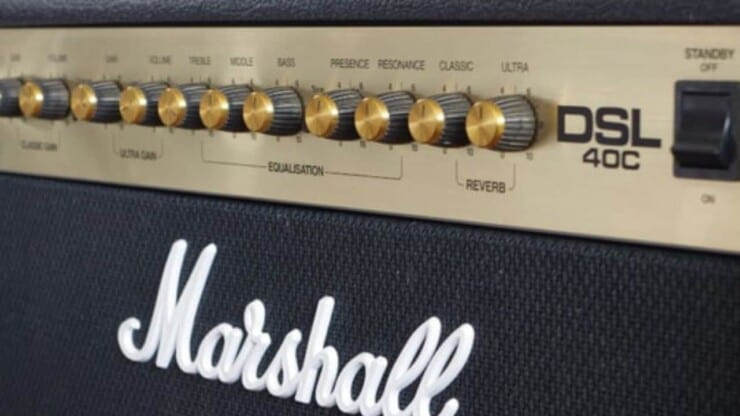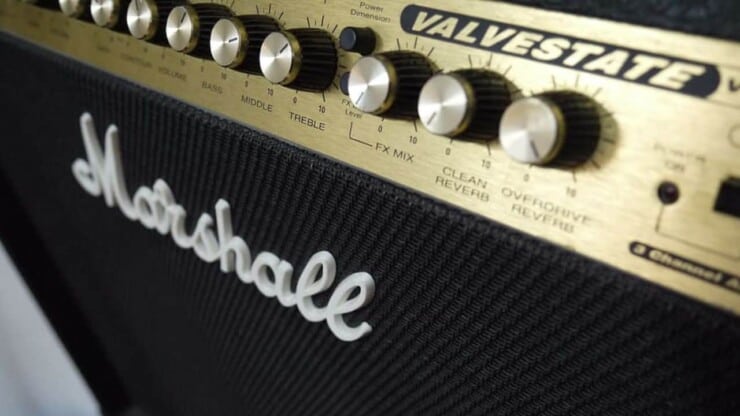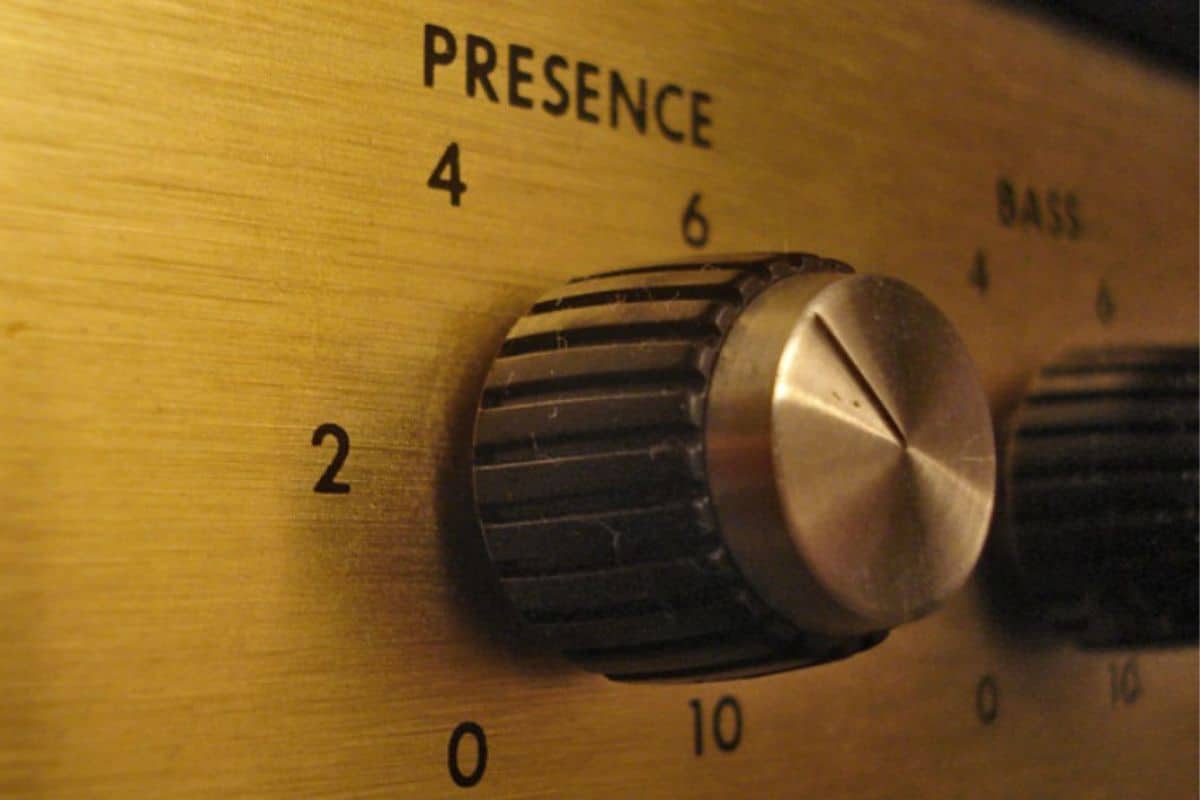Have you been learning to play the guitar but struggling with effects and knobs like presence? If so, then you’re not alone. Many beginners have trouble understanding presence knobs on guitar amps.
Presence on a guitar amp takes care of the treble response of the amp in the power sections. It means that once you have dialed the tone, you’ll be able to increase the brightness of the entire tone using presence.
In this article, you’ll get to know all about what is presence on a guitar amp, what does presence do on a guitar amp, how does it work, how to get better tones on a guitar amp, and what does the presence knob do on a guitar amp to give better tone among others. Continue reading to get all the answers.
What is presence on a guitar amp?
The presence control will take care of the overall treble response of the guitar amp from the power section. It essentially means that once you’ve dialed in the tone, you’ll be able to increase the overall brightness of the entire tone using the presence control. If you’ve turned the presence down, you’ll get a tone with a noticeable cut in the top end. This will be ideal if you’re using a bright set of pickups or finding the tone too harsh overall.
Higher presence settings will add attack and aggression to the amp’s top end. On a clean note, a high presence accentuates the percussive sound of the high end. If you’re boosting the presence on an overdriven sound, you’ll get a slightly more aggressive, biting overdrive tone. You can combine the controls with the features on your guitar amp and dial in the sound in your head.
Where are presence knobs located?
Most early single-channel guitar amps generally featured this knob in the power amp section that was connected to the feedback. There are many brands that use this location. The result of this location will change the high-frequency roll-off of the amp. This will be different from a treble control located in the preamp EQ section, called a shelving filter. Here, it’ll boost or cut the sound around a center point. At the center point, the treble knob will be neutral, and the tone will be passed through unchanged.
A presence knob will only roll off of or cut high frequencies. It’ll change its frequency of roll-off as it’ll be turned up and down. On later multi-channel amps, the presence knob got moved to the preamp section. This is generally located around the channel’s volume, where it can be on each channel. The result is similar, as it uses a locally located high-frequency roll-off filter. The thinking here is that the presence knob would boost frequencies like the other knobs, but it’s in the circuit backward, and it is just cutting less. It’s usually at the center position where you’ll achieve the amp designer’s intended sound.
Guitar amp’s tone with the presence knob
When used with the rest of the EQ controls, the presence knob can change the guitar’s tone quite drastically. This holds even more true when used with the treble knob. The roll-off of the presence will turn the treble knob into a peaking filter. Here, it’ll boost low treble tones with a narrower peak. It’ll enhance the bass and mids when turned down, as they’ll sound comparatively louder.
On the Legacy, V3, and V3M, the presence control will add high frequency in the 5-10kHz range when turned up. It is a higher range than where treble control begins adjusting, making it useful for further fine-tuning the tone. For a warmer sound, you’ll need to turn the presence down. On the other hand, you can turn it up to get added bite and clarity. You’ll want to adjust the treble once again to fine-tune further.
Although the presence control lends itself to crunchy rhythm guitar and searing leads when used with a thick overdrive, it’ll also be right at home with a clean tone. The presence control dubbed “Acoustic Presence Control” will be slightly different. It will come located in the amp section, but it’ll only work with clean channels. The point here is to allow you to adjust it for clean tones without affecting the soak channel. The presence knobs can adjust frequencies within the 8-20kHz range. When it is applied to a clean channel, it’ll add a subtle shimmer to the guitar’s high frequencies. This will be perfect for ringing out your chiming fat chords.
Similar to any other amp’s controls, it’ll pay to be judicious with your adjustments. While turning up the presence control can be helpful and add filling character to the guitar’s tone. Too much of it can clutter up the overall mix in the band. The singer’s voice, the sizzle from the snare drum, and the overtones of the piano also reside in the range of 5kHz and above. In such instances, turning down the presence might be the ticket to a sound that sits nicely in the mix. You can think of this as an additional tool for finding the sweet spot in the tone.
How does a presence knob work in a guitar amp?
Before getting into how does a presence knob work, it’s important to lay down the basics of amp design. In particular, you’ll want to understand the preamp and power amp stages. The preamp stage is where the majority of the tone-shaping will be done. Meanwhile, the power amp section offers the necessary power needed for driving the speakers and producing the desired sound level. An amp’s traditional Bass, Treble, and Mid controls will reside in the preamp stage.
Therefore, they’ll do the EQing before the signal has reached the power amp. These controls normally attenuate frequencies, which means they don’t boost anything, but rather control the amount of frequency band that you want to remove from the signal. The 1954 Twin was the first Fender amp to feature the Presence control.
The presence control actually lies in the power amp stage. Technically, what does presence mean on a guitar amp can be stated as a high-frequency shelving boost control similar to the treble control on a traditional stereo system. As the description suggests, the presence control will boost part of the frequency band.
Due to the nature of how power amps function, specifically power amp feedback, the presence affects upper mid and high frequencies. This is done in an entirely different way than normal tune controls found in the preamp stage. When increasing the presence control, you’ll decrease the amount of high-frequency feedback present in the power amp. This will cause the amp to distort easily for higher notes. It’ll also decrease the amp’s ability to control the speaker cone at high frequencies more accurately. It’ll allow the presence control to make the amp sound wilder and raspier in ways that the treble control knob cannot.
What does the presence knob do on a guitar amp?
It is obvious from the labels found on the amps what most controls on guitar amps do. The treble knob adjusts treble (high frequencies) while the Bass knob adjusts bass (low) frequencies and so forth. Many amps also come with a knob labeled “Presence”. Before cranking up the presence all the way up, there is what does presence do on a guitar amp.
First, you’ll need to know that the EQ and gain controls of the amp are a part of the preamp section of the amp. It means that they’ll do tone-shaping before the signal has reached the power amp and gets amplified to drive the speakers. The presence, on the other hand, is a part of the power amp section of the amp. Technically, it’ll operate as a high-frequency shelving boost. This is a fancy way of saying that it increases high frequencies, but doesn’t decrease them. You turn up high frequencies, but you cannot turn them down.
The presence control on the guitar amp is quite interactive with other EQ controls. It’ll directly adjust the frequencies about the treble control, but it’ll do more than that. Most presence controls will also change frequency roll off when adjusted. It means that the presence control can change the effect of the treble knob for sounding like a peaking instead of a shelving filter, as it’ll cause the treble frequencies to boost into a peak. This makes the amp sound much more aggressive and has more bite. Moreover, when you turn the presence down, it’ll seem to enhance the bass and midrange. This happens as they’ll sound relatively louder if there isn’t a treble peak.

Some amps like Friedmans and Marshalls sound present even without the presence control turned up. This means you can find the perfect, thick-yet-present tone with a lower setting on the presence knob. It will depend on the tone that you’re after, the amp, the speakers, the guitar, the effects, and so on. You should experiment and try to find the best setting for your particular guitar rig.
Proven ways to get a better tone from your guitar amp including presence
Dialing in a wonderful blues tone is no easy task. You’ll get to have all the key elements in place – an amazing guitar, a brilliant guitar amp, and the right pedals. For some reason, you struggle to get the tone that you want. The good news for you is that a lot of the time, this will have nothing to do with the rig you’re using. Instead, it will be about the way you set up your rig.
Crafting a great guitar tone will be both a science and art, and this is especially true in the blues. The blues is all about nuance, and you’ll be amazed at the difference small tweaks can make to your rig. At first glance, some of it may seem a bit obvious. However, small changes will add up and make a major difference to the tone and feel of your rig. Presence is a proven way of getting a premium tone from your guitar. Here are a few other tips to get the best out of your amp –
Use Treble and Presence to adapt to the environment
Before touching the guitar amp, you’ll first need to establish not just the tone that you want to create, but also the environment where you’ll be playing. What sounds great in your bedroom or a small studio might not sound good on stage. As soon as you begin playing with others, you will need to alter the amp setup. You need to think not just about the tone, but also about how you’ll cut through the mix.
When playing by yourself, chances are that you’ll favor a slightly darker tone. Very few guitarists are looking for sharp, biting tones when playing without accompaniment. They will lower the treble and presence on the amps while cranking the bass. It sounds wonderful when you are playing alone. In a band setting, you will be getting drowned out by the drummer and bassist.
In such situations, you’ll have to adjust your amp to increase the treble, mids, and presence. You can then roll the bass back. This may sound harsh on the ear when playing unaccompanied, but it’ll ensure that you’re heard when playing with others.
Live on the edge
With that said, there are guidelines that you need to follow to get a great ton regardless of the circumstances. One of the most important rules is to set the amp up such that the bass tone is on the edge of break up. You’ll want an overdriven tone, but one that is warm and will preserve the clarity and punctuation of each note. This is nice, easy, and can be done in multiple days depending on the type of amp you’re using. First, roll the volume on the guitar down to 7-8.
If your guitar amp features a master volume control, increase the volume at which you want to play. Then, slowly turn up the gain until you have a slightly overdriven tone. If your amp doesn’t have a master control, then you’ll need to drive the volume. Turn the volume control up until your guitar amp starts overdriving and breaks up.
Now, you need your base tone, and you’ll be good to go. If you’re looking to play the lead, crank up the volume to get an extra boost and an overdriven tone. If you’re looking to back off, you can soften the sound by applying less pressure with your picking hand. Setting the amp up in the sweet spot will give you more control and versatility. It’ll help you ensure that you are never straying too far from softly overdriven tones that sound amazing.
Do not forget your guitar
The tone that you are creating will always start with your guitar. Your amp will play a major part in helping you create a beautiful blues tone. The role that it plays will be purely reactive. It’ll react to how you’re playing the guitar, and crucially, to how you’re setting the volume and tone controls.
This may sound blindingly obvious, but it is a simple fact that many guitarists tend to overlook. Players change the settings of the amp and end up building unnecessarily large pedalboards for shaping the sound. They will do this while ignoring the tone-shaping controls on their guitar.
Dial on the amps
On every amp, regardless of brand, there will be a point on each pot where it’ll go from doing little to suddenly kicking in. As an example, you may find that you’ve got little added treble to the sound by moving the dial on the amp from 1-5. When you roll the dial to 6, your sound will suddenly become much brighter. The same will apply to bass and presence.

This is the level at which you’ll want to set each dial apart from reverb and other effects like tremolo included in the amp. Not only will the amp be well-balanced, but it’ll respond well to the nuances of your guitar playing. If you’re looking to get extra aggression and bite, dig in with your picking hand. If you want more warmth, back off a bit.
Give it a go with your amp, and you’ll find that it becomes more responsive. Your tone will improve instantly as a result. Moreover, you’ll feel more in control of your sound and how you can shape it.
Go for the granular
Every amp is very different. Moreover, amps react differently when paired with different instruments. Moreover, it may sound obvious, but there are some guitarists who buy new pedals and gear without testing them within the context of their own rig. Inevitably, it won’t sound the way that you imagine, and you will be left disappointed.
Take a look at the Ibanez Tube Screamer. Thanks to the remarkable tone of Stevie Ray Vaughan, the Tube Screamer has become one of the best-selling pedals of all time. Guitarists purchase pedals as they know that Stevie Ray Vaughan used them, and they’ll want to replicate his tones. The reality here is that you can sound like Vaughan to an extent only if you replicate his entire rig. The Tube Screamer sounds amazing when he used it, as it worked perfectly in conjunction with the Fender amps and the Fender Stratocaster.
If he had played the Gibson Es-335 and used Marshall amps, the pedals would have sounded entirely different. If you are looking to get the most out of the guitar amp, you should become a student of tone. Find how the amp is constructed and how it will respond to different pedals and effects as a result. This empowers you to make informed decisions when it will come to your sound. You should always buy pedals and guitars that complement your guitar rig. As a result, the tone will also sound much better.
Conclusion
Thank you for reading. Hopefully, now you know a lot more about what is presence on a guitar amp, what does presence do on a guitar amp, how does it work, how to get better tones on a guitar amp, and what does the presence knob do on a guitar amp to give a better tone among others. The presence on a guitar amp will be responsible for taking care of the treble response of the amp in power sections. This essentially means once you’ve dialed the tone, you will be able to increase the brightness of the entire tone thanks to the presence.
Image Credit:
Featured Image: Ultimate Guitar
Images: Musician’s HQ



